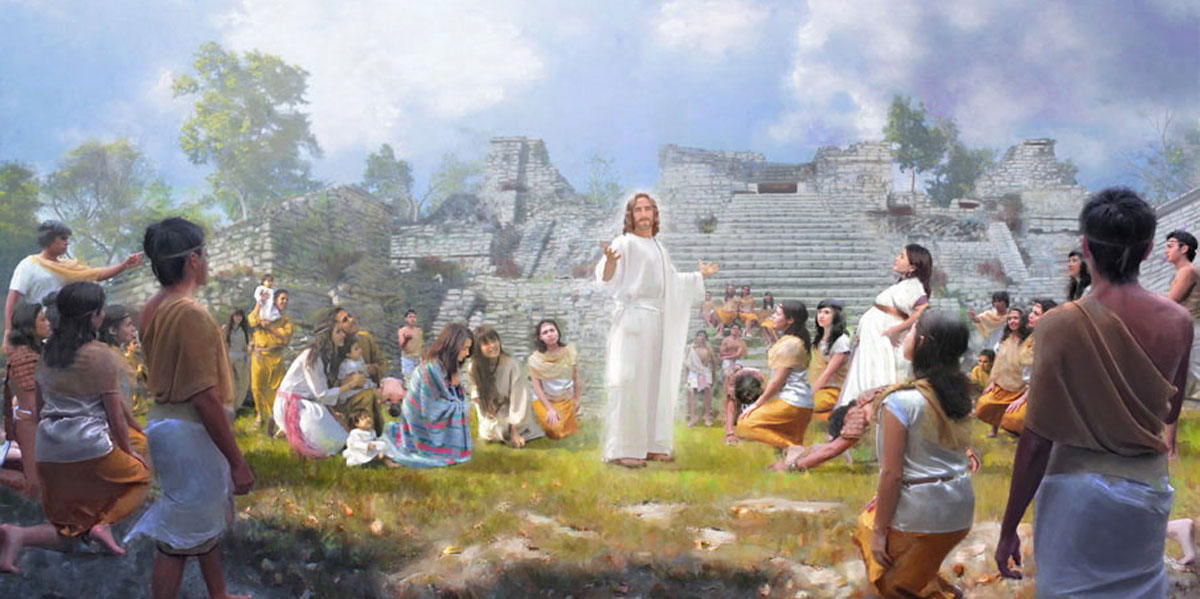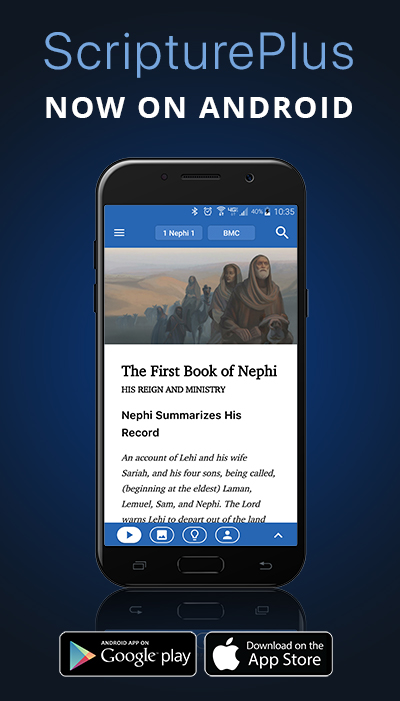/ KnoWhys / KnoWhy #282
Why Did the Lord Quote the Book of Mormon When Reestablishing the Church?

Post contributed by BMC Team
March 3, 2017
D&C KnoWhy #282

“And now behold, these are the words which ye shall say.”
The Know
On April 6, 1830, Joseph Smith and more than 50 others gathered in the log home of Peter Whitmer Sr. in Fayette, NY, to reorganize Christ’s church on the earth in modern times.1 Joseph and his associates had been anticipating and preparing for this day well in advanced of that time. Nine months earlier, in June 1829, as they were finishing up the translation of the Book of Mormon, the Lord told Oliver Cowdery to “rely upon the things which are written,” meaning the Book of Mormon, “for in them are all things written concerning the foundation of my church, my gospel, and my rock” (Doctrine and Covenants 18:3–4).2
In response to this revelation, Oliver began drafting the “Articles of the Church of Christ,” a first effort to set forth the basic administrative and procedural standards for the Church.3 According to historian Scott Faulring, “more than half of Cowdery’s Articles are either direct quotations or paraphrases with slight deviations from the Book of Mormon.”4 Between April and June 1830, Joseph began bringing forth what would soon become Doctrine and Covenants 20, which replaced Oliver’s 1829 Articles as the guiding administrative document of the Church.5 As with Oliver’s 1829 Articles, much of what was contained in that revelation was similar to what is found in the Book of Mormon.6
For example, the sacrament prayers, found in Doctrine and Covenants 20:77, 79, quote almost verbatim from the Book of Mormon.7 The two are so similar that, as John W. Welch has noted, in the first known printing of Doctrine and Covenants 20, which appeared in a newspaper account, simply states: “And the manner of baptism and the manner of administering the Sacrament are to be done as is written in the Book of Mormon,”8 rather than spelling out the full text of those prayers.9 Not only the words of the sacrament prayers, but also the instructions on how to administer the sacrament come from the Book of Mormon nearly verbatim (Doctrine and Covenants 20:76; Moroni 4:1–2).10
The procedures for baptism also show the same heavy reliance on the Book of Mormon, as illustrated by a side-by-side reading (see table).11
| Doctrine and Covenants 20:72-74 | 3 Nephi 11:23-26 |
| The person who is called of God … | Behold ye |
| shall go down into the water | shall go down and stand in the water, |
| with the person who has presented himself or herself for baptism, and | and in my name shall ye baptize them. And now behold, these are the words which ye |
| shall say, calling him or her by name: Having been commissioned of Jesus Christ, I baptize you in the name of the Father, and of the Son, and of the Holy Ghost. Amen. Then shall he immerse him or her in the water, and come forth again out of the water.12 | shall say, calling them by name, saying: Having authority given me of Jesus Christ, I baptize you in the name of the Father, and of the Son, and of the Holy Ghost. Amen. And then shall ye immerse them in the water, and come forth again out of the water”.13 |
Other examples could be cited, as well as more general similarities.14 As Welch noted, in both the Doctrine and Covenants, as in the Book of Mormon, “leaders of the Church are told to keep a list of the names of all members, numbering those who have been baptized and to blot out the names of those expelled from the Church.”15 Other similarities include leaders being “called” of God (1 Nephi 2:22; Jacob 2:3; Moroni 6:4; 7:2; 8:1), the purpose and conduct of meetings (Moroni 6), the principle that worship buildings should be simply decorated (Mosiah 11:7–10; Mormon 8:37), fasting together (Alma 6:6; 4 Nephi 1:2; Moroni 6:5), singing together (Alma 6:6; 4 Nephi 1:2; Moroni 6:5), preaching as led by the Holy Ghost (Moroni 6:9), meeting one day every week (Mosiah 18:25), and holding conferences (Mosiah 2–5; Alma 5, 7) are all laid down in the Book of Mormon.16
The Why
The similarities between Doctrine and Covenants 20 and texts in the Book of Mormon show the importance of the Book of Mormon for the Restoration. They also show that the Lord organized His church in a similar way in each dispensation. The Lord told Joseph, “I will establish my Church yea even the church which was taught by my disciples in the days of old.”17 The points of contact between these texts show that He did just that.
Reading the Doctrine and Covenants and the Book of Mormon side by side shows that Joseph relied on the Book of Mormon in reestablishing the Church. This reliance on the Book of Mormon allowed him to make the Church similar to Christ’s ancient church in both the Old and New World. This is a reminder to modern readers of the Book of Mormon that Christ’s church today is remarkably similar to His church in ancient times, and that God is indeed “unchangeable from all eternity to all eternity” (Mormon 8:18).
The organizing principles of Christ’s church were not simply created in modern times. They are the same as they were in ancient times and are found in the Book of Mormon. As Welch has noted, the Book of Mormon’s “ordinances and administrative principles are not just convenient or optional things to do in a would-be church of Christ. They provide the essential and integral organizational principles and framework upon which the Church of Christ is truly established.”18
Further Reading
John W. Welch, “The Book of Mormon as the Keystone of Church Administration,” Religious Educator 12, no. 2 (2011): 83–117, reprinted in A Firm Foundation: Church Organization and Administration, ed. David J. Whittaker and Arnold K. Garr (Salt Lake City and Provo, UT: Deseret Book and Religious Studies Center, Brigham Young University, 2011), 15–58.
Scott H. Faulring, “An Examination of the 1829 ‘Articles of the Church of Christ’ in Relation to Section 20 of the Doctrine and Covenants,” BYU Studies 43, no. 4 (2004): 57–91.
John A. Tvedtnes, The Most Correct Book: Insights from a Book of Mormon Scholar (Salt Lake City, UT: Cornerstone Publishing, 1999), 291–316.
Scott H. Faulring, “The Book of Mormon: A Blueprint for Organizing the Church,” Journal of Book of Mormon Studies 7, no. 1 (1998): 60–69, 71.
1. See Michael Hubbard MacKay, Sacred Space: Exploring the Birthplace of Mormonism (Salt Lake City and Provo, UT: Deseret Book and the Religious Studies Center, Brigham Young University, 2016).
2. Scott H. Faulring, “The Book of Mormon: A Blueprint for Organizing the Church,” Journal of Book of Mormon Studies 7, no. 1 (1998): 63.
3. Book of Mormon Central, “Was the Book of Mormon Used As the First Church Administrative Handbook? (3 Nephi 27:21–22),” KnoWhy 72 (April 6, 2016). See also Scott H. Faulring, “An Examination of the 1829 ‘Articles of the Church of Christ’ in Relation to Section 20 of the Doctrine and Covenants,” BYU Studies 43, no. 4 (2004): 64.
4. Faulring, “An Examination,” 67.
5. Jeffrey G. Cannon, “Build Up My Church,” Revelations in Context, January 3, 2013, online at history.lds.org.
6. Though it is less dependant on the Book of Mormon than the 1829 Articles. Faulring, “An Examination,” 67: “Careful textual comparison of Cowdery’s 1829 Articles against this early copy of D&C 20 reveals that Oliver Cowdery’s document is far more dependent on the Book of Mormon text than is the latter. Roughly one-fifth of section 20 relies on the Book of Mormon for its text, while more than half of Cowdery’s Articles are either direct quotations or paraphrases with slight deviations from the Book of Mormon.”
7. See Book of Mormon Central, “Where did Moroni Get the Sacramental Prayers from? (Moroni 4:1),” KnoWhy 250 (December 12, 2016). The sacrament prayers were also included in Cowdery’s 1829 Articles.
8. John W. Welch, “The Book of Mormon as the Keystone of Church Administration,” Religious Educator 12, no. 2 (2011): 90. Other early versions of Doctrine and Covenants 20, instead of writing out the exact words of the prayers, simply refer the reader to “Book of Mormon, Page 175” or place the material from Moroni 4–5 and 3 Nephi 11 in quotation marks.
9. For more on this, see John A. Tvedtnes, The Most Correct Book: Insights from a Book of Mormon Scholar (Salt Lake City, UT: Cornerstone Publishing, 1999), 304–306.
10. Welch, “Administration,” 90.
11. Welch, “Administration,” 90.
12. For more on this, see Tvedtnes, Most Correct Book, 299–301.
13. Welch, “Administration,” 90.
14. For more on the how the Nephite church operated, as similarities to the church today, see Robert E. Parsons, “The Practices of the Church: Moroni 1–6,” in The Book of Mormon, Part 2: Alma 30 to Moroni, ed. Kent P. Jackson, Studies in Scripture: Volume 8 (Salt Lake City, UT: Deseret Book, 1988), 282–292.
15. Welch, “Administration,” 90. Compare Doctrine and Covenants 20:82 to Mosiah 6:1; 3 Nephi 30:2; Moroni 6:4. Also compare Doctrine and Covenants 20:83 to Mosiah 5:11; 3 Nephi 18:31; Moroni 6:7.
16. For more on some of these topics, see Book of Mormon Central, “Why Did Fasting and Prayer Accompany Nephite Mourning? (Alma 28:6),” KnoWhy 135 (July 3, 2016); Book of Mormon Central, “Why Was Singing Hymns a Part of Nephite Worship Services? (Moroni 6:9),” KnoWhy 251 (December 13, 2016); Book of Mormon Central, “Is there Precedent for General Conference in the Book of Mormon? (3 Nephi 11:1),” KnoWhy 199 (September 30, 2016).
17. This revelation comes from the Book of Commandments 4:5. Robin Scott Jensen, Richard E. Turley Jr., and Riley M. Lorimer, eds., Revelations and Translations, Volume 2: Published Revelations, The Joseph Smith Papers (Salt Lake City, UT: Church Historian’s Press, 2011); See also Gerald E. Smith, Schooling the Prophet: How the Book of Mormon Influenced Joseph Smith and the Early Restoration (Provo, UT: Neal A. Maxwell Institute for Religious Scholarship, 2015), 223 n.5.
18. Welch, “Administration,” 112.

